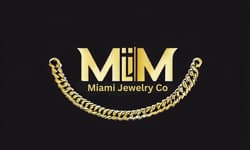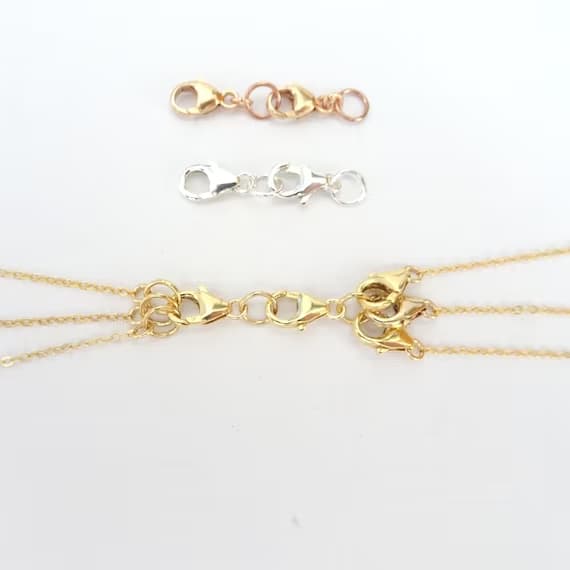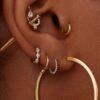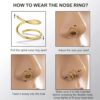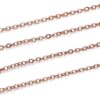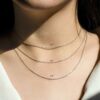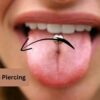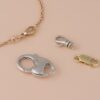Necklaces Guide
11 Different Types of Necklace Clasps (Closures): How to Choose & What You Need to Know
Have you ever struggled with opening or closing your necklace clasp?
Do you find it hard to choose the right clasp for your jewelry? If you answered yes to any of these questions, then this guide is for you.
Necklace clasps are the small but essential components that connect the ends of a necklace and allow you to wear it with ease. They come in various shapes, sizes, and styles, each with its own advantages and disadvantages. Choosing the wrong clasp can ruin your look, damage your necklace, or even cause you to lose it.
That’s why we have created this comprehensive guide on 11 types of necklace clasps: how to choose and what you need to know.
In this guide, you will learn:
- The features, benefits, and drawbacks of each type of clasp, from spring ring clasps to snap lock clasps.
- How to choose the right clasp for your necklace based on factors such as size, weight, design, and security.
- Everything you need to know about necklace clasps, such as how to use them properly, how to care for them, and when to replace them.
- The answers to some frequently asked questions about necklace clasps
By the end of this guide, you’ll be a clasp connoisseur, equipped to make informed choices for your jewelry and keep it secure and stunning.
Here’s a look at the main types of necklace clasps and which one is the most suitable for you.
Contents
- 1 Spring Ring Clasps – The most common type of Necklace Clasps
- 2 Lobster Clasps
- 3 Toggle Clasps
- 4 Magnetic Clasps
- 5 Box Clasps
- 6 Barrel Clasps
- 7 Hook and Eye Clasps (Traditional Type Necklace Clasps)
- 8 S Hook Clasps
- 9 Fishhook Clasps
- 10 Slide Lock Clasps
- 11 Snap Lock Clasps
- 12 Comparison Table of Different Types of Necklace Clasps
- 13 How do Jewelry Clasps Work? – Video Guide
- 14 How to Choose the Right Necklace Clasp for Your Jewelry
- 15 Everything You Need to Know About Necklace Clasps
- 16 How to Properly Care for Your Necklace Clasp
- 17 When to Replace a Clasp
- 18 FAQs Related to Types of Necklace Clasps
- 19 Conclusion
Spring Ring Clasps – The most common type of Necklace Clasps
Spring Ring Clasps are common necklace fasteners. They have a metal ring with a spring. Push a lever, and the ring opens. They’re good for light necklaces and are cheap. But, they can break easily. If they’re tiny or stiff, they’re hard to use by yourself.
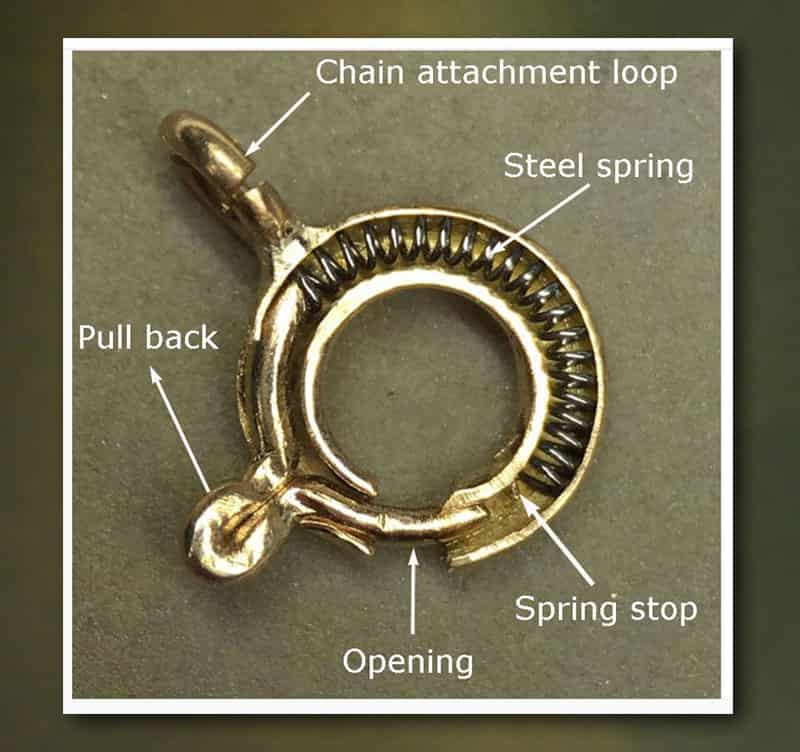
How Spring Ring Clasps Work
A spring ring clasp has a hollow metal ring that contains a spring inside. The spring is attached to a small lever that protrudes from the ring. When you push the lever, the spring compresses and the ring opens. When you release the lever, the spring expands and the ring closes. To use a spring ring clasp, you need to attach one end of the necklace chain to the ring and the other end to a jump ring or a loop. Then, you need to push the lever of the spring ring clasp and hook it onto the jump ring or the loop. To remove the necklace, you need to reverse the process.
- Related: 16 vs 18 Inch Necklace
How to Choose Spring Ring Clasps
When choosing a spring ring clasp, you need to consider the following factors:
- Size: Ensure the clasp’s size complements the necklace chain and is manageable.
- Material: The clasp should match your necklace’s material and be hypoallergenic.
- Design: Aim for a clasp that aligns with the necklace’s style and the occasion it’s worn for.
What You Need to Know About Spring Ring Clasps
Here are some tips and tricks to help you make the most of your spring ring clasps:
- Keep your spring ring clasps clean and well-maintained. Dirt, dust, oil, and moisture can affect the performance and appearance of your spring ring clasps. To clean them, you can use a soft cloth, warm water, mild soap, and a toothbrush. Avoid using harsh chemicals or abrasives that can damage your clasps. To maintain them, you can apply some lubricant or polish to keep them smooth and shiny.
- Replace your spring ring clasps if they become loose or broken. Over time, your spring ring clasps may lose their tension or break due to wear and tear. This can compromise the security and comfort of your necklaces. To prevent this, you should check your clasps regularly and replace them if they show any signs of damage or malfunction.
- Use pliers or tweezers to help you open and close your spring ring clasps. If you have trouble opening and closing your spring ring clasps by yourself, you can use some tools to assist you. For example, you can use pliers or tweezers to hold one end of your necklace while you push the lever of the clasp with your fingers. This can make it easier for you to hook or unhook your clasp without dropping or tangling your necklace.
Lobster Clasps
Lobster Clasps are favored necklace fasteners shaped like a lobster’s claw. They use a spring-loaded lever which you pull to open and release to close. These clasps are sturdier and last longer than spring ring clasps. They’re available in many sizes, shapes, and materials. However, they often cost more than spring ring clasps and can be a bit challenging to use if the lever is tough to handle.
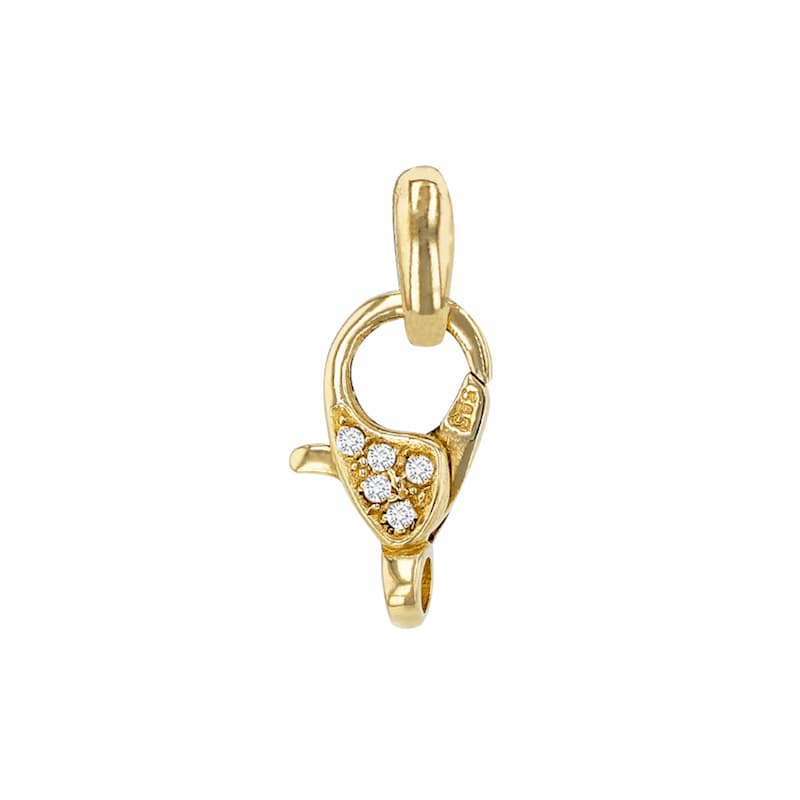
How Lobster Clasps Work
A lobster clasp has a metal claw that has a spring inside. The spring is attached to a lever that extends from the claw. When you pull the lever, the spring compresses and the claw opens. When you release the lever, the spring expands and the claw closes. To use a lobster clasp, you need to attach one end of the necklace chain to the claw and the other end to a jump ring or a loop. Then, you need to pull the lever of the lobster clasp and hook it onto the jump ring or the loop. To remove the necklace, you need to reverse the process.
How to Choose Lobster Clasps
- Size: A clasp that suits the necklace chain size ensures secure fastening.
- Material: Match the clasp’s material to the necklace and prioritize durability and hypoallergenic properties.
- Aesthetic: The clasp should match the necklace’s style and the intended wearing occasion.
What You Need to Know About Lobster Clasps
Here are some tips and tricks to help you make the most of your lobster clasps:
- Keep your lobster clasps clean and well-maintained. Dirt, dust, oil, and moisture can affect the performance and appearance of your lobster clasps. To clean them, you can use a soft cloth, warm water, mild soap, and a toothbrush. Avoid using harsh chemicals or abrasives that can damage your clasps. To maintain them, you can apply some lubricant or polish to keep them smooth and shiny.
- Replace your lobster clasps if they become loose or broken. Over time, your lobster clasps may lose their tension or break due to wear and tear. This can compromise the security and comfort of your necklaces. To prevent this, you should check your clasps regularly and replace them if they show any signs of damage or malfunction.
- Use pliers or tweezers to help you open and close your lobster clasps. If you have trouble opening and closing your lobster clasps by yourself, you can use some tools to assist you. For example, you can use pliers or tweezers to hold one end of your necklace while you pull the lever of the clasp with your fingers. This can make it easier for you to hook or unhook your clasp without dropping or tangling your necklace.
Toggle Clasps
Toggle Clasps are two-piece necklace locks made of a ring and a bar. To lock it, you put the bar through the ring and turn it. They are easy to use and look nice on necklaces. But, if the ring or bar is too big or small, they might open by themselves. They aren’t good for heavy necklaces.
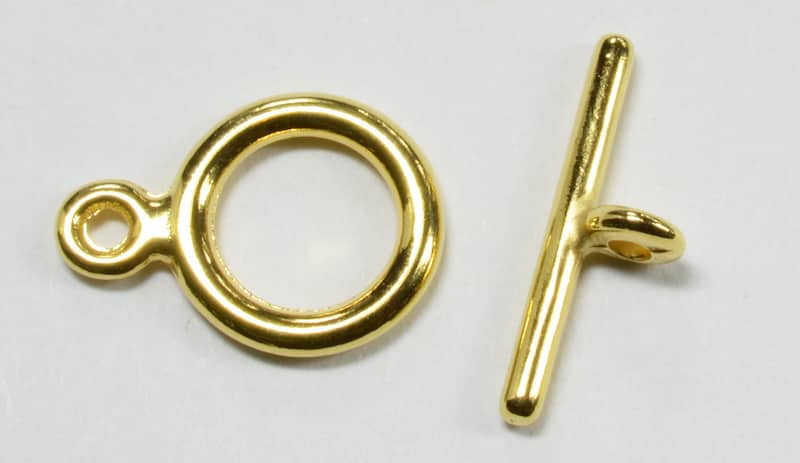
How Toggle Clasps Work
A toggle clasp has two parts: a ring and a bar. The ring is usually round or oval in shape and has an opening on one side. The bar is usually straight or curved in shape and has two ends that are wider than its middle section. To use a toggle clasp, you need to attach one end of the necklace chain to the ring and the other end to the bar. Then, you need to insert the bar through the opening of the ring and rotate it until it lies perpendicular to the ring. This will lock the clasp in place. To remove the necklace, you need to reverse the process.
How to Choose Toggle Clasps
When choosing a toggle clasp, you need to consider the following factors:
- Size: Ensure that neither the ring nor the bar is too large or too small for secure fastening.
- Material: The clasp’s material should be both durable and hypoallergenic.
- Design: Given their potential as a decorative feature, choose a design that enhances the necklace’s overall look.
Magnetic Clasps
Magnetic clasps use the power of magnetism to keep your necklace secure, making them both modern and efficient.
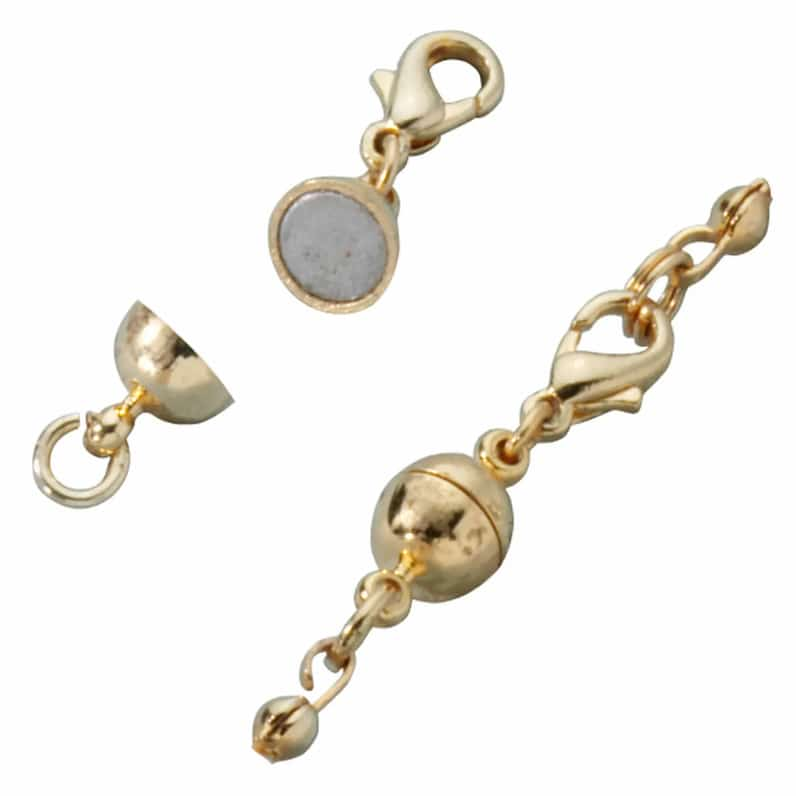
How Magnetic Clasps Work
Magnetic clasps comprise two pieces, each with a magnetic end. When the two ends are brought close together, they attract, securing the necklace. To separate them and open the necklace, simply pull the two ends apart.
How to Choose Magnetic Clasps
- Strength: Opt for a clasp with a strong magnet, especially if the necklace is heavy.
- Material: Ensure the magnets are encased in hypoallergenic material to avoid skin reactions.
- Style: Magnetic clasps come in various designs; choose one that complements your necklace.
What You Need to Know About Magnetic Clasps
- They are among the easiest clasps to use, especially for those with dexterity issues.
- Over time, the strength of magnets can diminish, so regular checks are essential.
Box Clasps
Box clasps are elegant and can often be an ornate part of the necklace design itself.
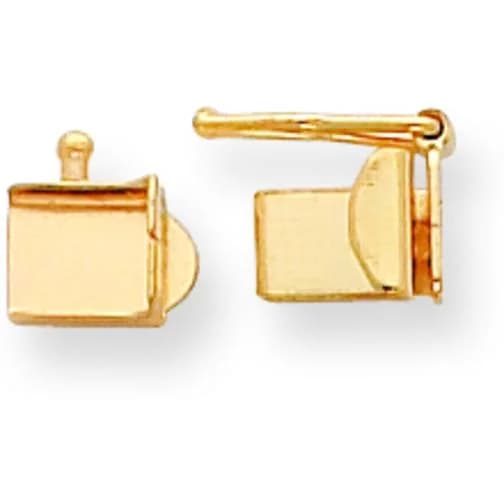
How Box Clasps Work
One part of a box clasp is shaped like a box, while the other is a flat piece that slots into the box. The flat piece clicks into place when inserted, securing the necklace. To release, there’s usually a mechanism to press or pinch, allowing the flat piece to be removed.
How to Choose Box Clasps
- Secure Mechanism: The click should be firm, ensuring the necklace remains secure.
- Design: Given that box clasps can be ornate, pick a style that matches or enhances your necklace.
- Material: Opt for durable materials that won’t tarnish or discolor over time.
What You Need to Know About Box Clasps
- These clasps can be a focal point of a necklace, adding to its overall design.
- Care should be taken to ensure the mechanism doesn’t weaken over time.
Barrel Clasps
Resembling the shape of a barrel, these clasps are both functional and sleek.
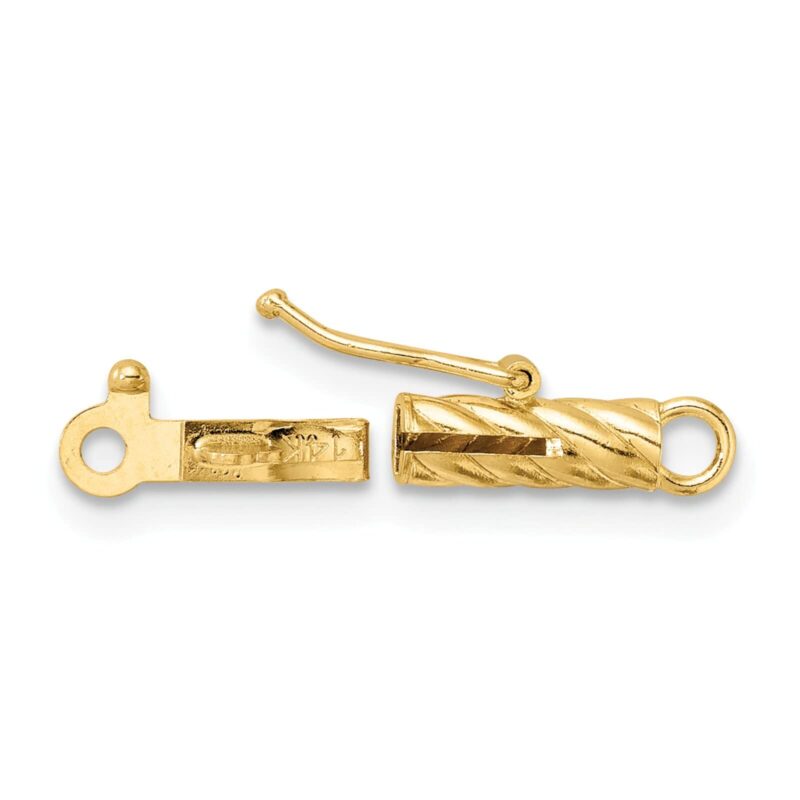
How Barrel Clasps Work
A barrel clasp consists of two metal pieces, each shaped like half a barrel. One half has a screw mechanism, while the other has a threaded hollow center. The two pieces screw together to close the necklace and unscrew to open it.
How to Choose Barrel Clasps
- Screw Quality: Ensure the threads are well-made, allowing for smooth screwing and unscrewing.
- Material: Like other clasps, it’s important to choose non-tarnishing, hypoallergenic materials.
- Size: Depending on the necklace’s thickness, choose a barrel clasp size that is proportional.
What You Need to Know About Barrel Clasps
- Regularly check the screw mechanism for any signs of wear and tear.
- While functional, they may not be as ornate or decorative as other clasps, making them suitable for simpler necklace designs.
Hook and Eye Clasps (Traditional Type Necklace Clasps)
Traditional and timeless, hook-and-eye clasps offer a basic yet effective way to secure jewelry.
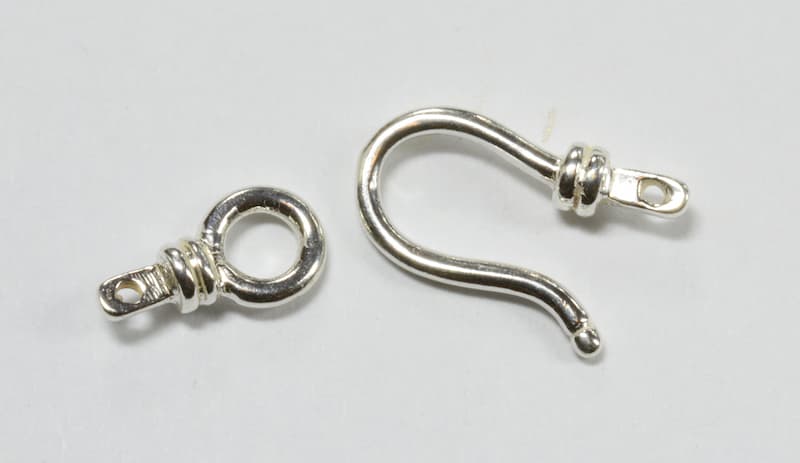
How Hook and Eye Clasps Work
This clasp consists of a hook and a loop (or ‘eye’). To fasten, the hook is simply inserted into the eye. To unfasten, it’s gently pulled out.
How to Choose Hook and Eye Clasps
- Size Compatibility: Ensure the hook is proportionate to the eye for a secure fit.
- Material: Choose durable, non-tarnishing metals that match or complement the necklace’s material.
- Design: These clasps can be ornate or simple, so select a style that aligns with your necklace’s aesthetic.
What You Need to Know About Hook and Eye Clasps
- They’re among the oldest types of clasps and can give jewelry a vintage appeal.
- Regular checks are vital to ensure the hook remains straight and fits snugly into the eye.
S Hook Clasps
Resembling the letter ‘S’, these clasps are both decorative and functional.
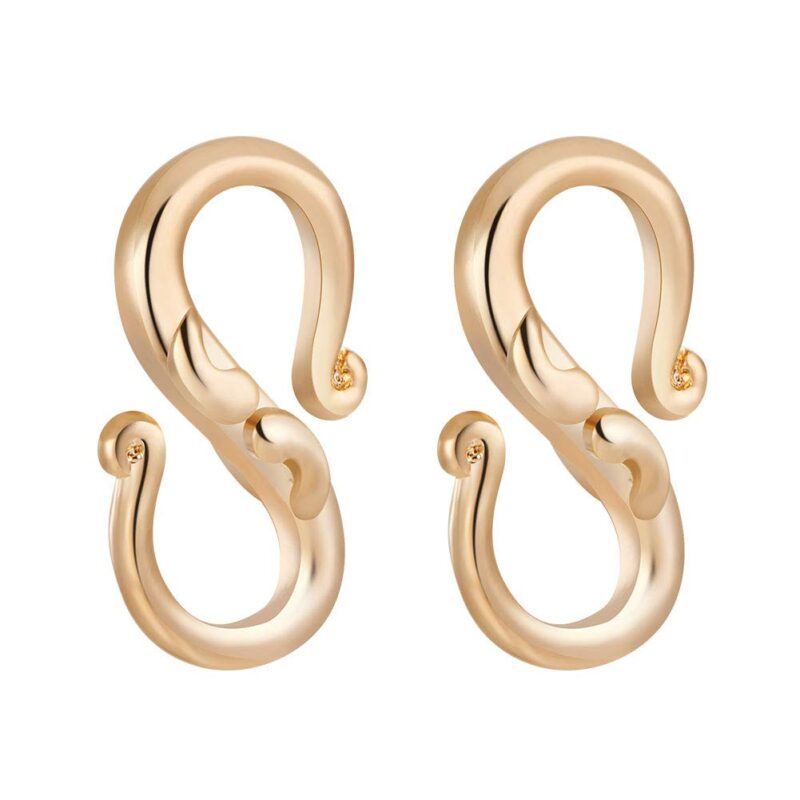
How S Hook Clasps Work
The clasp is shaped like an ‘S’. One looped end attaches to one end of the necklace while the other looped end hooks onto the opposite end.
How to Choose S Hook Clasps
- Security: Ensure the curvature of the ‘S’ is sufficient to prevent accidental unhooking.
- Size: It should be proportional to the necklace’s thickness and length.
- Material: As always, opt for durable, hypoallergenic metals.
What You Need to Know About S Hook Clasps
- These clasps can serve as decorative elements, especially when crafted with intricate designs.
- Regular adjustments might be required to maintain the shape of the ‘S’.
Fishhook Clasps
As the name implies, these clasps resemble the hook used in fishing and are known for their secure fastening.
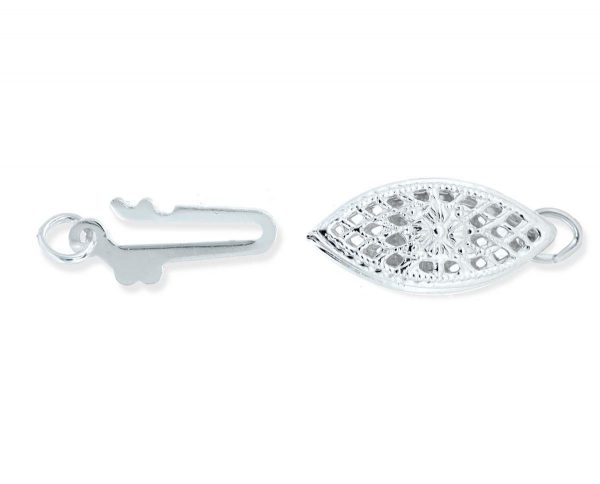
How Fishhook Clasps Work
A hook is inserted into an oval-shaped case, securing the two ends of the necklace.
How to Choose Fishhook Clasps
- Ease of Use: Ensure the hook can be easily inserted and removed from the case.
- Size & Design: Choose one that complements the necklace’s design and size.
- Material: Quality metals that are resistant to wear are best.
What You Need to Know About Fishhook Clasps
- They’re particularly popular in pearls and other delicate necklaces.
- Regular inspection is essential to ensure the hook maintains its shape.
Slide Lock Clasps
Slide Lock Clasps are primarily used for multi-strand necklaces or bracelets.
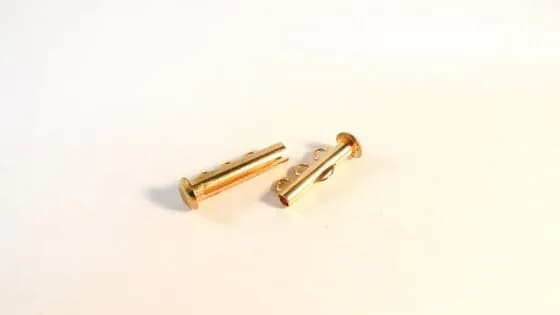
How Slide Lock Clasps Work
Consisting of two tubes, one slides inside the other and locks into place.
How to Choose Slide Lock Clasps
- Security: Ensure the locking mechanism is strong and stays in place.
- Size: Match the size to the width and number of strands.
- Material: Durable, quality metals are preferable.
What You Need to Know About Slide Lock Clasps
- Perfect for layered necklaces or bracelets with multiple strands.
- Periodic checks will ensure the slide mechanism functions correctly.
Snap Lock Clasps
Easy and straightforward, these clasps are all about convenience.
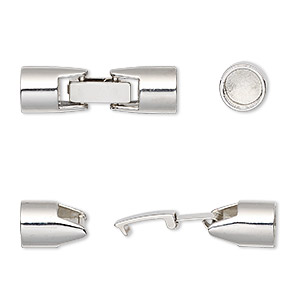
How Snap Lock Clasps Work
Working similarly to a snap button, one end has a protruding mechanism that ‘snaps’ into the other end.
How to Choose Snap Lock Clasps
- Snapping Sound: A clear ‘snap’ sound typically indicates a secure lock.
- Size & Style: Choose one that doesn’t overpower the necklace but complements its design.
- Material: Opt for quality metals that won’t easily wear out.
What You Need to Know About Snap Lock Clasps
- They’re commonly found in modern jewelry due to their ease of use.
- Ensure regular checks to maintain the snapping mechanism’s efficiency.
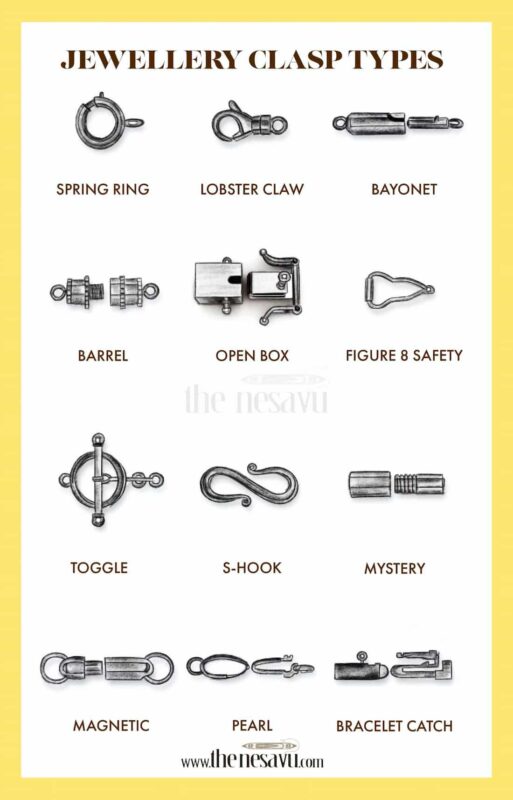
Comparison Table of Different Types of Necklace Clasps
| TYPE OF CLASP | DESCRIPTION | PROS | CONS |
|---|---|---|---|
| Spring Ring | Common clasp with a spring-operated opening mechanism. | Cheap, suitable for light necklaces. | Can break easily, hard to use if tiny or stiff. |
| Lobster | Resembles a lobster claw with a spring-loaded lever. | Very easy to use, and modern. | Sturdy, durable, and available in various designs. |
| Toggle | Two-piece lock made of a ring and a bar. | Easy to use, decorative. | Can open if not proportioned correctly, not for heavy necklaces. |
| Magnetic | Uses magnetism to secure. | The mechanism might weaken over time. | Strength may diminish over time. |
| Box | Ornate clasp with a box and a slotting piece. | Can be a design highlight, elegant. | Not as ornate, need to check the screw mechanism regularly. |
| Barrel | Two pieces that screw together. | Sleek design, functional. | Needs checks to ensure the slide mechanism functions correctly. |
| Hook and Eye | Traditional clasp with a hook and loop system. | Timeless, can have a vintage appeal. | Needs checks to ensure snug fit. |
| S Hook | The mechanism might weaken over time. | Decorative, functional. | May require shape adjustments. |
| Fishhook | Clasp is shaped like the letter ‘S’. | A hook is inserted into an oval case. | Requires regular inspection. |
| Slide Lock | Used for multi-strand pieces; one tube slides into another. | Ideal for layered jewelry. | Needs checks to ensure slide mechanism functions correctly. |
| Snap Lock | Works like a snap button, one end snaps into the other. | Simple, common in modern jewelry. | Requires regular checks for snap mechanism. |
How do Jewelry Clasps Work? – Video Guide
How to Choose the Right Necklace Clasp for Your Jewelry
When choosing a necklace clasp, there are several factors to consider, such as:
Weight and Size
The weight and size of the necklace. You want a clasp that can support the weight and size of your necklace without breaking or coming undone. For example, a spring ring clasp may not be strong enough for a heavy or bulky necklace, while a toggle clasp may not be suitable for a thin or lightweight necklace.
Aligning the Clasp with Necklace Design
The style and design of the necklace. You want a clasp that matches the style and design of your necklace, whether it is simple or elaborate, modern or vintage, casual or formal. For example, a box clasp may look elegant on a pearl necklace, while a magnetic clasp may look fun on a beaded necklace.
Prioritizing Ease and Comfort of Use
The ease and comfort of use. You want a clasp that is easy and comfortable to use, especially if you plan to wear your necklace often or for long periods of time. For example, a lobster clasp may be easier to open and close by yourself than a spring ring clasp, while a magnetic clasp may be ideal for people who have difficulty with other types of clasps.
Balancing Budget and Personal Preference
The budget and preference. You want a clasp that fits your budget and preference, whether you are looking for something cheap or expensive, simple or fancy, plain or decorative. For example, a barrel clasp may be cheaper than a box clasp, while a toggle clasp may be more fancy than an S hook clasp.
Everything You Need to Know About Necklace Clasps
Necklace clasps are not only functional but also fashionable components of your jewelry. Here are some tips and tricks to help you make the most of your necklace clasps:
Maintaining Clasp Appearance and Functionality
Keep your necklace clasps clean and well-maintained. Dirt, dust, oil, and moisture can affect the performance and appearance of your necklace clasps. To clean them, you can use a soft cloth, warm water, mild soap, and a toothbrush. Avoid using harsh chemicals or abrasives that can damage your clasps. To maintain them, you can apply some lubricant or polish to keep them smooth and shiny.
Matching Clasps with Your Ensemble
Choose your necklace clasps according to your outfit and occasion. Different types of necklace clasps can create different effects on your outfit and occasion. For example, a lobster clasp may look more professional than a toggle clasp, while a magnetic clasp may look more playful than a box clasp. You can also mix and match different types of clasps to create different looks and styles.
Add Creativity with Varied Clasps
Experiment with different types of necklace clasps to express your personality and creativity. There are many types of necklace clasps available in the market, each with its own unique features and benefits. You can try different types of clasps to see what suits you best and what makes you happy. You can also customize your clasps with charms, beads, crystals, or other embellishments to make them more personal and special.
How to Properly Care for Your Necklace Clasp
Wearing a beautiful necklace makes you feel special, but taking care of every component, including its clasp, ensures it remains a treasure for a lifetime. Let’s delve deeper into how you can pamper and maintain that little but essential piece of your necklace.
Maintenance and Cleaning Tips
- Regular Checks: Just as you periodically inspect your shoes for wear or your car for any issues, the same care should be applied to your necklace clasps. Over time, they can become loose or misaligned. Ensure the mechanism functions smoothly, and there are no visible signs of wear.
- Gentle Cleaning: Believe me, it’s all too easy to let dirt and grime accumulate on your necklace clasp. Use a soft-bristled brush or cloth, dip it into mild soapy water, and gently scrub the clasp. Ensure you rinse it with clean water afterward.
- Drying: Always dry your clasp properly. Leaving it wet can lead to rusting, especially if it’s not made from a rust-resistant material. After cleaning, pat it dry with a soft cloth and allow it to air dry completely before storing.
- Avoid Harsh Chemicals: You might be tempted to use strong cleaning agents, but resist the urge. These can erode the metal or cause discoloration. Stick to gentle, jewelry-friendly cleaning solutions.
- Storage Tips: When you’re not wearing your necklace, store it flat in a jewelry box with compartments. This ensures the chain doesn’t get tangled and the clasp isn’t under any stress. And remember, keeping necklaces away from direct sunlight will help retain their luster.
When to Replace a Clasp
Jewelry, like all things, experiences wear and tear. And clasps, being the workhorses they are, can sometimes bear the brunt of it.
Recognizing Signs of Wear and Tear
- Looseness: Over time, the spring or mechanism inside some clasps may become less effective. If you find that your clasp isn’t snapping shut as it once did or feels wobbly, it’s a sign.
- Visible Rust or Discoloration: This is a tell-tale sign that your clasp is aging. Any visible rust or color change means the metal is reacting to moisture or chemicals, and it’s time to get a replacement.
- Difficulty in Operation: If you’re struggling more than usual to open or close the clasp, it may be wearing out.
- Personal Experience: A piece of advice from someone who’s learned the hard way – don’t wait for a mishap. I once lost a precious necklace because I ignored the obvious signs that the clasp was deteriorating. It’s always better to replace it sooner rather than regret it later.
FAQs Related to Types of Necklace Clasps
What are the names of different necklace clasps?
Necklace clasps come in various designs, each serving a unique purpose and aesthetic. Some common types include:
- Lobster Claw
- Spring Ring
- Toggle
- Barrel
- Magnetic
- Box
- Bolo
- S Hook
- Fishhook
- Slide Lock
- Gabriella
What is the strongest type of necklace clasp?
The most secure jewelry clasps include the lobster, hook, and spring ring clasps. The lobster clasp, with its two-part design, offers exceptional strength, while hook and eye clasps are ideal for heavier jewelry due to their tension-based security.
What is the difference between a lobster claw and a toggle clasp?
A lobster claw clasp operates with a spring mechanism and is shaped like a lobster’s claw. It’s opened and closed by pulling a small lever. A toggle clasp, on the other hand, consists of a bar and ring. The bar is threaded through the ring and then turned, securing the necklace. While lobster claw clasps offer more security, toggle clasps are often chosen for their decorative appeal.
What is a barrel clasp on a necklace?
A barrel clasp, resembling the shape of a barrel, consists of two metal pieces that screw together to secure the necklace. When both ends are joined and twisted, they lock securely, making it a discreet and functional clasp type.
What is a bolo clasp?
A bolo clasp, commonly seen on bolo ties, comprises a metal piece that slides up and down a cord or chain. The tension within the clasp holds it in place, allowing for adjustable lengths. They’re known for their ease of use and versatile design adaptability.
What is a Gabriella clasp?
A Gabriella clasp is a lesser-known but highly secure clasp type. It involves a mechanism where a hook wraps around a bar, followed by a latch folding over the hook to lock it in place. This double security feature ensures the necklace stays put.
Conclusion
Choosing the right necklace clasp, caring for it, and knowing when to replace it are all essential aspects of preserving your treasured jewelry. From understanding the significance of necklace weight and length to the paramount importance of safety and security, every detail counts.
In my decade-long journey with jewelry, I’ve realized that while the sparkle and design capture our hearts, it’s often the overlooked details, like clasps, that determine the longevity and utility of a piece. Just like a book isn’t judged by its cover, a necklace shouldn’t only be valued for its pendant or chain; the clasp plays an equally pivotal role.
Related
- Silver Chains To Wear With A Pendant
- Cuban Link Chain Size
- Cuban Chain vs Curb Chain
- Hollow Rope Chain vs Solid
- 5mm vs 7mm Cuban Link Chain
- 3mm vs 5mm Cuban Link Chain
- Franco Chain vs Cuban Link
- What is a Wheat Chain
- Franco vs Wheat Chain

Camila Luna is a passionate jewelry enthusiast and content creator at Miami Jewelry Co. With a focus on providing high-quality, Miami-style jewelry, Camila and her team specialize in a wide range of jewelry that includes bracelets, necklaces, earrings, and more
